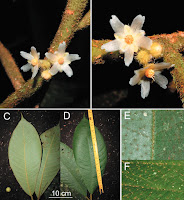 |
| Saurauia abbreviata K.R.Mazo in Mazo, Mansibang, Aribal & Tamayo, 2021 DOI: 10.36253/jopt-10712 Photo by Kean Roe Mazo, Illustrated by Jayson Mansibang. |
Abstract
A new species and a rediscovery in the genus Saurauia (Actinidiaceae) from Zamboanga Peninsula, Mindanao island, Philippines are presented here. The new species, Saurauia abbreviata, closely resembles Saurauia lanaensis Merr. but can be differentiated by having longer petioles, uniformly setose adaxial leaf surface, longer and wider leaves, more lateral veins, 3 styles, and a 3(–4)-locular ovary. This discovery raises the current number of recognized Saurauia in the Philippines to 57 following an 87-year gap in the taxonomic study of this genus in the country. S. longipedicellata Merr. is also rediscovered after almost a century. A lectotype is here assigned for this name selected among the syntypes. Photographs, ecological notes, and an amended description are also provided to aid taxonomic identification.
Keywords: Actinidia, Actinidiaceae, endemism, Philippines, taxonomy
 |
| Saurauia abbreviata K.R.Mazo sp. nov. A & B. Inflorescence; C. Leaf (abaxial view); D. Leaf (adaxial view); E. Abaxial leaf setae (close up); F. Adaxial leaf setae (close up). Photos by Kean Roe Mazo. |
Saurauia abbreviata K.R.Mazo, sp. nov.
Diagnosis: Saurauia abbreviata closely resembles Saurauia lanaensis Merr. by having densely setose branchlets, abaxially setose leaves, small, axillary, cymose inflorescence; setaceous sepals; short sepals and petals. How-ever, the new species can be differentiated by having longer petioles (1.5–4.0 cm vs. 1.0–1.5 cm), uniformly setose adaxial leaf surface (vs. glabrous), longer and wider leaves (20–42 cm long × 9.5–17 cm wide vs. 11–20 cm long × 3.0–6.0 cm wide), more lateral veins (14–25 pairs vs. 10–12 pairs). In terms of floral characters, S. lanaensis has slightly larger petals and sepals vs. S. abbreviata. Notably, the older inflorescences in S. abbreviata forms a slightly thick woody rachis from which new flowers emerge after the senescence of the older ones—a characteristic not known to occur in S. lanaensis.
Saurauia longipedicellata Merr.,
Philipp. J. Sci. 20, 1922: 407
Kean Roe F. Mazo, Jayson A. Mansibang, Lowell G. Aribal and Maverick N. Tamayo. 2021. You ‘Sau’ Me! A New Species and A Rediscovery in the Genus Saurauia (Actinidiaceae) from Zamboanga Peninsula, Mindanao Island, Philippines. Webbia: Journal of Plant Taxonomy and Geography. 76(2); 203-212. DOI: 10.36253/jopt-10712
Abstrak. Usa ka bag-ong species ug nadiskobrehan pag-usab sa genus nga Saurauia (Actinidiaceae) gikan sa Zamboanga Peninsula, isla sa Mindanao, Philippines ang gipresentar dinhi. Ang bag-ong species, Saurauia abbreviata, nahisama pag-ayo sa Saurauia lanaensis Merr. apan ang bag-ong species adunay labi ka taas nga mga petioles, uniformly setose ang ilalom nga dahon, mas taas ug mas lapad nga dahon, labi pang mga lateral veins, 3 styles, ug 3(–4)-locular nga obaryo. Ang nadiskobrehan nagdugang sa kadaghanon sa mga giila nga Saurauia sa Pilipinas ngadto sa 57 human sa 87 ka tuig nga gintang sa taxonomic nga pagtuon sa kini nga genus sa nasud. Ang Saurauia longipedicellata Merr. nadiskobrehan usab pagkahuman sa hapit usa ka gatus ka tuig. Ang tipipikasyon gihimo dinhi aron mapalig-og ang ngalan. Mga litrato, mga notang ekolohikal, ug giusab nga hulagway alang sa maong species makita usab dinhi.





